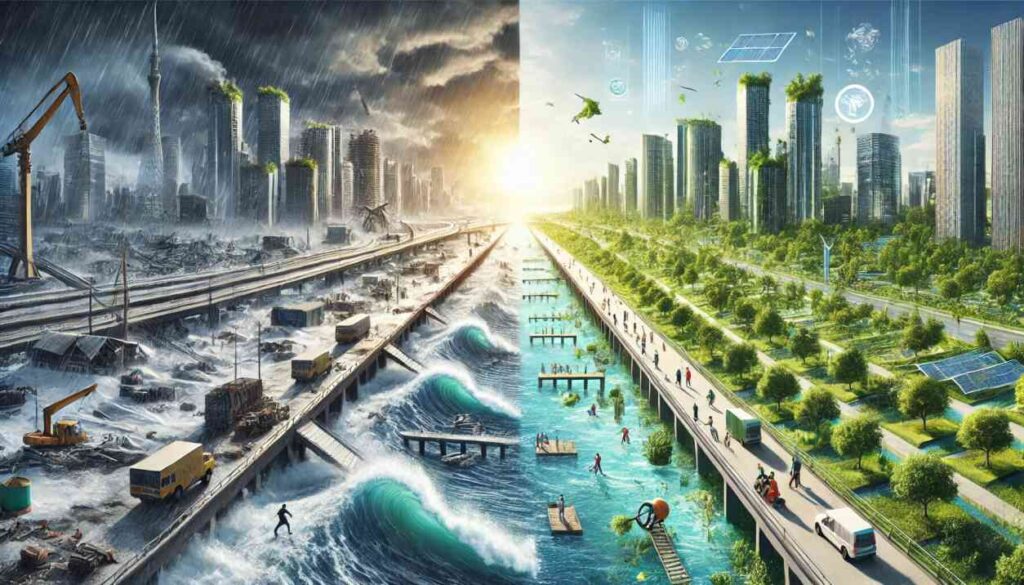
Climate change is no longer a hypothetical future challenge—it’s a lived reality. From devastating floods in Asia to unprecedented wildfires in North America and persistent droughts across Africa, the effects of climate change are everywhere, touching economies, ecosystems, and communities alike. In this new era of uncertainty, two concepts are central to how we respond: climate risk and climate resilience.
Understanding these concepts isn’t just for scientists or policymakers anymore. It’s essential knowledge for every business leader, urban planner, farmer, and citizen who wants to help build a more sustainable, secure, and prepared world.
Understanding Climate Risk
Climate risk refers to the potential for harm or disruption due to climate-related events. It affects infrastructure, livelihoods, supply chains, health systems, and natural ecosystems. Climate risks are typically classified into two key categories:
1. Physical Risks
These are the direct risks from environmental and weather-related events:
- Floods and hurricanes damaging homes and infrastructure
- Wildfires threatening communities and ecosystems
- Droughts reducing agricultural productivity
- Rising sea levels eroding coastlines
- Heatwaves endangering public health and food systems
Physical risks can result in economic loss, humanitarian crises, and systemic shocks across sectors.
2. Transition Risks
These arise as the world shifts toward a low-carbon economy. As governments, investors, and consumers demand climate action, companies face:
- Stricter environmental policies and carbon regulations
- Disruption from clean technology adoption
- Changing market dynamics and customer expectations
- Reputation damage for failing to adapt
Together, these risks define the new landscape that decision-makers must navigate.
Defining Climate Resilience
Climate resilience is the capacity to anticipate, adapt to, and recover from climate impacts. But it’s more than just survival. It’s about transforming systems to withstand future shocks and still thrive.
Being climate-resilient means:
- Building infrastructure that can handle rising seas and extreme heat
- Creating early warning systems and emergency plans
- Empowering farmers to adopt drought-resistant crops
- Protecting biodiversity to buffer natural disasters
- Designing cities with green roofs, shaded public spaces, and flood control systems
The focus is not only on reacting to disasters, but on proactive adaptation—taking steps now to reduce future harm.
The Urgency of Resilience
Climate events are no longer rare. They’re frequent, widespread, and deeply disruptive. Building resilience is no longer optional—it’s urgent.
Consider these examples:
- Bangladesh’s cyclone shelters and warning systems have drastically reduced fatalities during storms.
- The Netherlands, long vulnerable to flooding, now leads the world in adaptive water management.
- California has implemented stringent building codes and fire mitigation strategies to protect high-risk communities.
These are not one-time responses. They are systemic investments in resilience that combine technology, policy, infrastructure, and community engagement.
What Builds Climate Resilience?
Achieving true climate resilience requires coordinated action across sectors. Here are five pillars that underpin strong resilience strategies:
1. Risk Identification and Mapping
Governments and businesses must begin with accurate risk assessments. Mapping flood zones, drought-prone regions, or heat islands helps prioritize adaptation efforts.
2. Infrastructure Modernization
Bridges, roads, buildings, and energy systems must be upgraded to withstand more frequent extreme weather. This includes stormwater drainage systems, resilient power grids, and climate-resilient housing.
3. Nature-Based Solutions
Restoring mangroves, forests, and wetlands can absorb storm surges, reduce flooding, and maintain ecosystem balance. These “natural defenses” are cost-effective and sustainable.
4. Education and Community Engagement
Resilience is strongest when communities understand their risks and take part in solutions. Public awareness campaigns, school programs, and participatory planning are key.
5. Financial Instruments
Tools like parametric insurance, climate adaptation funds, and green bonds can finance early response and recovery, reducing reliance on post-disaster aid.
Climate Risk and Business
No sector is immune to climate risks. For businesses, the impacts are growing more direct:
- Operations and supply chains are increasingly disrupted by climate events.
- Investors are demanding climate risk disclosures and sustainable practices.
- Regulatory frameworks are tightening globally.
- Consumers prefer brands aligned with environmental responsibility.
Resilience is fast becoming a competitive advantage. Businesses that invest in risk assessments, carbon-neutral strategies, and climate-aligned supply chains will not only survive but lead.
Equity at the Heart of Resilience
Climate change doesn’t affect everyone equally. Marginalized communities—particularly low-income groups, women, children, and indigenous populations—often face the highest risks with the fewest resources.
True resilience must be inclusive. It means:
- Engaging at-risk communities in planning
- Providing access to funding and climate tools
- Considering social and cultural realities in solutions
- Ensuring policies don’t deepen existing inequalities
Equity and resilience go hand in hand. One cannot succeed without the other.
Learn Climate Risk and Resilience – A Practical Guide
To help organizations, professionals, and individuals better understand and act on climate risk, we’ve developed a 3-hour self-paced course titled Climate Risk and Resilience.
You’ll learn:
- What climate risk is and how it’s measured
- Strategies and frameworks for building resilience
- Real-world case studies and global examples
- Policy and business tools to mitigate future risks
- How to apply these insights in your organization or community
Whether you’re a policymaker, urban planner, NGO worker, student, or business strategist, this course provides the tools to take informed action.
Conclusion: Resilience is the New Strategy
We can no longer afford to treat climate resilience as a long-term project. It must be embedded in our current systems, budgets, and strategies. The cost of inaction is already high—and rising.
By understanding climate risks and taking steps to strengthen resilience, we not only protect what we have—we build a better, fairer future.
Climate risk is real. But so is our capacity to respond. Let’s build that capacity—together.


